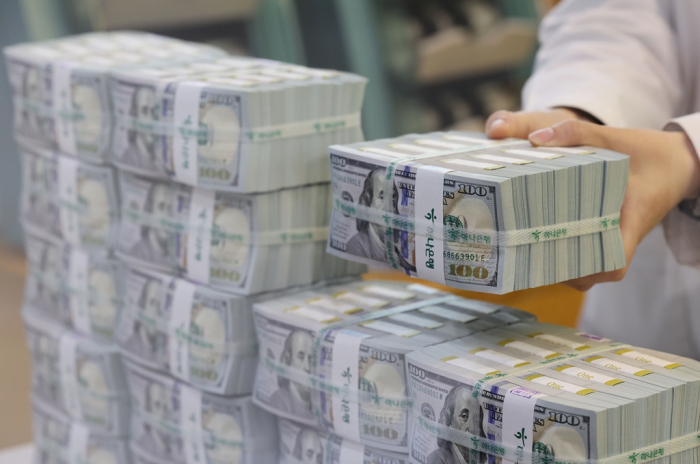Foreign exchange
Korean exporters suffer FX derivate losses on weak won
Samsung Elec sees $8.7 billion loss from currency derivatives in first three quarters; number of firms with such deficits surges
By Nov 17, 2022 (Gmt+09:00)
3
Min read
Most Read
LG Chem to sell water filter business to Glenwood PE for $692 million


Kyobo Life poised to buy Japan’s SBI Group-owned savings bank


KT&G eyes overseas M&A after rejecting activist fund's offer


StockX in merger talks with Naver’s online reseller Kream


Mirae Asset to be named Korea Post’s core real estate fund operator



More South Korean exporters suffered massive losses from foreign exchange derivatives on a weaker won, failing to benefit from the unit’s depreciation that often boosts the converted value of overseas sales and price competitiveness.
In the first three quarters of this year, 21 listed companies reported losses from currency derivative trading, according to the Financial Supervisory Service (FSS) data. The number was more than ten times the two firms with such shortfalls a year earlier.
The 21 companies saw a total of 352.8 billion won ($263.4 million) in realized losses and 204 billion won in valuation losses during the period. The two listed companies that reported currency derivative losses in the first three quarters of 2021 logged realized losses of a combined 14.3 billion won and valuation losses of 16.9 billion won, respectively.
Among the 21 companies, 15 firms are smaller ones with a market capitalization of 500 billion won or less. Listed companies are required to report derivative losses through filings to the FSS only when such deficits exceed 10% of their equity capital, while major firms are supposed to reveal those shortfalls when they top 5% of their capital.
The currency derivatives losses in the January-September 2022 period are likely to be much larger than the total if such deficits from larger companies that do not need to report to the financial regulator are included.
BOOMERANG OF FX HEDGES
Companies heavily dependent on exports often sign derivative contracts such as futures or forwards on about half of foreign orders to hedge against the volatilities in foreign exchange markets. But excessive volatilities force them to lose money from the derivatives.
Many companies had derivative contracts to sell dollars at the won’s value of around 1,200 against the US currency in the futures or forward markets, but the won depreciated to as weak as 1,444.2 in October, the softest level since the 2008-09 global financial crisis. That resulted in losses of more than 200 won per dollar in some cases.
Some companies benefited from trade receivables in dollars due to the won’s weakness but they were not enough to offset losses from the derivatives. Some of them lost all of their profits for this year due to the derivative losses.
The won has recently recovered to levels firmer than 1,400 per dollar with a domestic close of 1,339.1 on Thursday, helping those companies reduce some losses. But the local currency needs to strengthen further to 1,200 in order to prevent more derivative losses as many firms still have derivative contracts to be expired next year to sell dollars at the won’s value of around the level, industry sources said.
The won was one the worst performers among emerging Asian currencies with an 11.2% depreciation against the greenback so far this year.
SEMICONDUCTOR, DISPLAY SECTORS
Among the 21 companies with currency derivative losses, 10 firms were in the semiconductor and display industries, adding to concerns over their earnings hit by downturns in the sectors.
SFA Engineering Corp., a semiconductor and display equipment maker, reported a realized loss of 69 billion won in the first three quarters. Its operating margin rose to 13.2% in the third quarter by 4.2 percentage points from the previous three months, but its net profit nearly halved to 20.7 billion won from a year earlier.
Techwing Inc., which supplies semiconductor equipment to SK Hynix Inc., suffered 13.3 billion won in foreign exchange derivative losses in the first three quarters, slightly lower than a net profit of 17.1 billion won for the entire 2021. The company turned to the red in the third quarter with a net loss of 6 billion won.
Dong A Eltek Co., a display equipment producer, had been expected to enjoy healthy profits due to the strong organic light-emitting diode (OLED) industry. But the company reported a quarterly net loss of more than 27 billion won due to a currency derivative loss of 34.2 billion won.
Major companies that heavily rely on exports were also estimated to have logged massive losses.
Samsung Electronics Co., the world’s top memory chipmaker, already reported a combined 1.2 trillion won in foreign exchange derivative losses in the January-September period with 2,717 currency forward contracts in total.
Write to Eui-Myung Park at uimyung@hankyung.com
Jongwoo Cheon edited this article.
More to Read
-
 Foreign exchangeKorea won sees best day in nearly 14 yrs, may be climbing from bottom
Foreign exchangeKorea won sees best day in nearly 14 yrs, may be climbing from bottomNov 11, 2022 (Gmt+09:00)
2 Min read -
 Central bankBOK takes another big step hike as weak won lifts prices
Central bankBOK takes another big step hike as weak won lifts pricesOct 12, 2022 (Gmt+09:00)
3 Min read -
 EconomySinking won fans doubts over Korea’s economic fundamentals
EconomySinking won fans doubts over Korea’s economic fundamentalsSep 29, 2022 (Gmt+09:00)
4 Min read -
 Corporate strategyWeaker won offers no leg up for Korean exporters
Corporate strategyWeaker won offers no leg up for Korean exportersSep 23, 2022 (Gmt+09:00)
5 Min read
Comment 0
LOG IN


